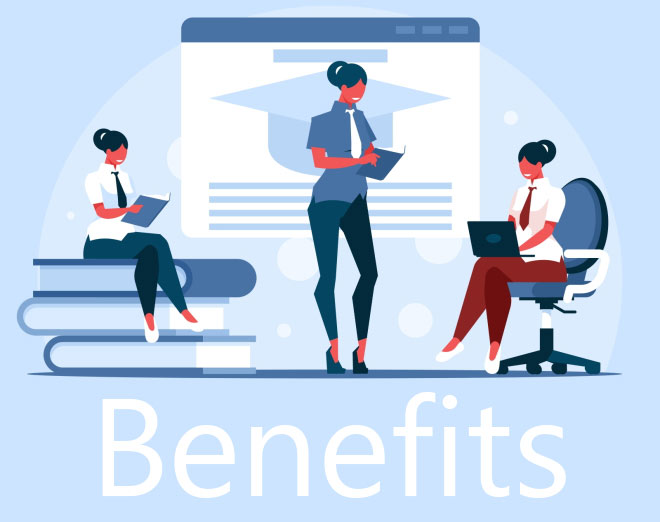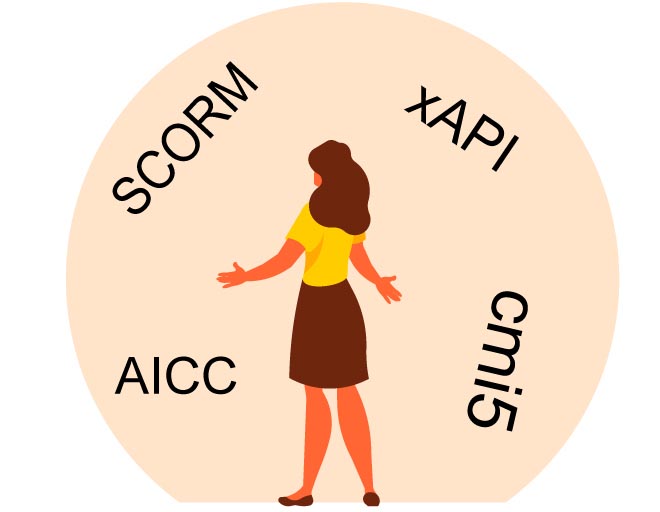Learning about SCORM helps people to turn their as simple as PowerPoint presentation content into a real SCORM online course which they can upload into any Learning Management System. SCORM allows the easy content distribution to other SCORM-compliant platforms, which was impossible before 2001 when there was no way to create and transfer online courses to multiple LMS platforms. This article provides a complete guide to what the SCORM standard and its alternatives are. Let’s find out.
What is SCORM?
SCORM, which stands for Shareable Content Object Reference Model, is a technical standard for eLearning training courses. In simple words, SCORM governs how the content of eLearning course and LMS communicate with each other.
As a standard for e-Learning software product SCORM tells the developers of online courses and LMS to design the content in such a way that both are compatible with each other, so that any SCORM conformed online course content is compatible with any SCORM conformed Learning Management System.
How does SCORM Help Us?
Back in the 90s, digital training was limited to the platform it was created on. It was in 2001 when SCORM was first officially introduced in the world of eLearning that the digital courses become transferrable across different eLearning platforms.
Before SCORM, an online course manufactured in one LMS was un-operable on any other LMS. As a result, in the past, if any organization changed its LMS, it would lose all the content of its online courses just because its eLearning courses were meant to run on the previous LMS and were not compatible with the new LMS.
So basically a SCORM-compliant LMS brings order to all e-learning courses and now any SCORM-compliant online course can be ported or accessed in any SCORM-compliant learning management system.
How do SCORM Standard and Its Alternatives Work in The Digital World?
SCORM consists of three important components required to deliver an online course via LMS:
1. Content Packaging
Any LMS needs a specific kind of information about any eLearning course to properly import and launch the course. SCORM governs this content packaging, which “packages” all the files of an online course into a SCORM package.
This SCORM package (zip. file) now has all the structured information needed by an LMS to launch the online course on its platform. It determines how the course can be delivered to end users.
2. Run-time Communication
The data exchange between the specific LMS and the learning is the responsibility of run-time communication. The run-time communication actually deals with “Content Delivery as well as the tracking of content”.
This feature of SCORM governs how the learning content “finds” and “talks” to the LMS. For example, it is with the help of “Run-time Communication” that the instructions or commands like “get the Learners name” or “inform LMS that learner scores highly in test” are exchanged between the learning content and LMS.
3. Sequencing
The third important component of SCORM, which is needed to deliver the eLearning course on any LMS platform, is sequencing. Sequencing is responsible for tracking how a learner/user navigates through the course.
SCORM File
The major question which is usually asked and roams in our mind is “How exactly the eLearning courses are transferred across LMS with the help of SCORM?”. The answer is, via “SCORM File”.
SCOs which stands for Shareable Content Objects are the pieces of eLearning courses (SCOs also include a manifest file). It can be in the form of a document or the form of pages. These are anything that can be tracked by LMS and uploaded to the platform as the learning material of the eLearning course.
SCORM governs how all the eLearning content should be structured in a transferrable zip file, called the SCORM file. Then the file is structured according to standards of SCORM, the standards needed to transfer any learning content to any LMS. In the next section of SCORM Standard and Its Alternatives you will find about benefits from using SCORM standard.

Benefits of the SCORM
The benefits one gets after using SCORM are:
1. Compatibility
Almost all modern LMS will recognize a SCORM-based eLearning course and will be compatible with any kind of course.
2. Clear Course Format
SCORM allows for the clear structuring of course content. Using SCORM, authors can specify what needs to be done first and what needs to be done second. For example, to take the final test, the learner has to take the following lectures and watch the final video, and only then will the final test be unlocked.
3. Keep Track of Progress
The major advantage of SCORM is that it helps students keep their progress saved. The learners can go through the online course step by step, and they won’t have to revise the whole content all at once. The progress will be “bookmarked”.
4. Feedback is Given
This is a very useful feature. Every time a student completes a course, a single question or other activity, feedback can be given to both the user and the author. This will often include the score gained by the user and the status, e.g. “Course is completed”.
5. Training Material is in Module Form
As mentioned earlier in this SCORM Standard and Its Alternatives article, the eLearning course content is considered an individual learning object in SCORM. The training material often consists of single modules, and these modules can be used in any other online course in the same LMS. For example, if the video from chapter 2 of one course can be helpful in the 3rd chapter of the second course, SCORM can allow the usage of that single module in both the courses.
Versions of SCORM
To this date, a total of three versions of SCORM are launched in the market, which are:
1. SCORM Version 1.1
This is the first version instroduced to the eLearning market. Before the launch of SCORM 1.1, there was only a draft that informed about the incoming work. The SCORM Version 1.1 was launched to show that the SCORM is an implementable specification, not just an idea.
2. SCORM Version 1.2
SCORM version 1.2 addresses many issues related to version 1.1. It immediately became one of the widely recognized eLearning software products. It gained popularity and almost all LMSs started to shift to version 1.2. Now, almost all LMSs support this version.
3. SCORM Version 1.3
SCORM 2004 also known as SCORM 1.3 is the latest version of SCORM. This version allows authorities (content developers) more control over learner’s behavior. For example, the “Sequencing” component we mentioned above is the part of SCORM 2004 that shows the user navigation in the course.
In previous versions, content developers have no insight into the learner’s behavior. After 1.2, this is the most widely used SCORM version because it is the latest and has many useful features.
What Alternatives Are There for SCORM?
It is usually assumed that SCORM is dead but the reality is different than this. Amy Rouse, a Learning Expert mentioned in her LinkedIn post about the Decline and Fall of SCORM that:
“SCORM is not dead, but it is past its prime”
(https://www.linkedin.com/pulse/decline-fall-scorm-why-you-should-care-amy-rouse/)
This clearly shows that SCORM is not that popular now and there are many more beneficial alternatives to SCORM available in the market. These alternatives to the SCORM standard give content developers more control over the learner’s efficiency and provide them more data regarding the efficiency of their eLearning.


The three most prominent alternatives to SCORM standards in the eLearning market are:
1. xAPI
The most commonly used alternative to the SCORM standard is xAPI, which is also known as the Experience API or Tin Can. The xAPI provides the same functionality as SCORM but in a much more sophisticated and detailed manner. It was developed in 2013 and the main difference between xAPI and SCORM is the “Ability to track learning”.
In the case of SCORM, the learning can only be tracked in an LMS compliant with SCORM, but in the case of xAPI, the learning can be tracked, recorded, personalized, and improved in any kind of context.
Another great difference between SCORM and xAPI is that xAPI can record and keep track of learning offline and on mobile phones as well. In the case of SCORM, due to security restrictions, the learning content cannot be shared across the LMSes working in different domains. This means that SCORM does not support cross-domain communication.
For example, if a widely spread organization needs to share the learning content between their LMSes based on different domains, it can get difficult to do so. This also shows that when the learners access the learning material on their mobile phones without internet connectivity, their progress will not be recorded.
xAPI solves these minor but important issues. It allows offline learning, learning tracking, and cross-domain communication as well.
4 Reasons why You need to Switch from SCORM to xAPI – SCORM Standard and Its Alternatives
It’s clear from the discussion above that xAPI has advantages over SCORM Here are four obvious reasons why you should switch to xAPI from SCORM:
Deliver and track a range of learning contexts
SCORM is limited to online LMS platform whereas xAPI can work in almost all contexts and track learner experiences no matter when and where the activity happens.
Have in-depth insights into detailed learning behaviors
SCORM is limited to only specific kinds of learning insights like when the course is completed, how much score one gained in the quiz, and how much time has been spent on a specific course by the user.
But xAPI allows more in-depth insights into learning behaviors like the user’s navigation, next step they take, etc.
More personalization
More data and more detailed insights into user activity allow the content developers to create more personalized eLearning courses. This allows users to have more tailored content that is better suited to their needs, which in turn translates into overall progres.
Face-to-Face, informal learning activities
SCORM does not support informal learning activities, while xAPI supports and records all kinds of activities, including webinars, podcasts, face-to-face calls, short courses, and other informal learning activities.
2. AICC
AICC is even older than SCORM and has many problems that were resolved in SCORM standard. For example, uploading of content takes a long time in AICC as compared to SCORM. The only point where AICC has an advantage over SCORM is “security”. The standard of AICC is more secure than SCORM.
3. Cmi5
cmi5 is a profile of xAPI that fills the gap between SCORM and xAPI by specifying interoperability standards such as launching, reporting, authorization, and course structure that govern how an LMS and xAPI-enabled eLearning activities interact with each other.
Last Remarks
Most of the SCORM-supported software is still working on SCORM version 1.2, which was released in 2001. Since then, SCORM 1.2 features and updates have remained the same but digital expectations and capabilities have increased and organizations are looking for a more reliable option that can provide more data on their eLearning courses.
In just 20 years since the release of SCORM, it is already becoming outdated and will become a serious limitation as the eLearning potential evolve in the coming years unless there are some major updates to SCORM. Moreover, it is clear from the above discussion that xAPI is more reliable than SCORM, and given the updated features, it will stay with us for a long time. In this article you learned the basics regarding the SCORM standard and its alternatives. If you wish to find out more about the e-learning industry, follow us on LinkedIn and Twitter.



